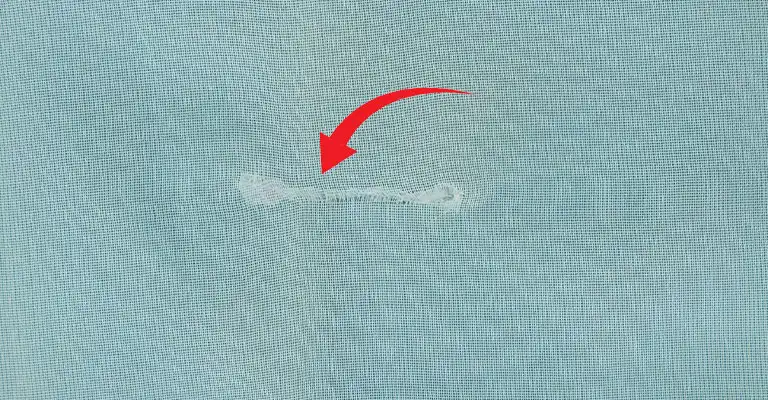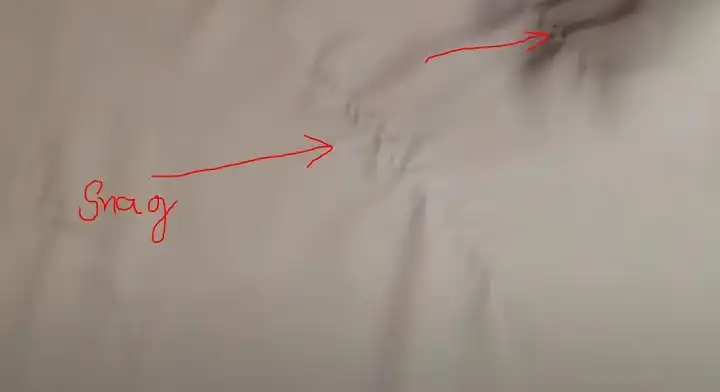Chiffon, a lightweight and sheer fabric, adds an elegant touch to any wardrobe. Its delicate nature, however, makes it susceptible to snags, which can be disheartening for those who cherish their chiffon garments.
It, also known for its ethereal beauty and delicate texture, is a fabric that requires special care. Unfortunately, snags can be a common woe for chiffon enthusiasts. In this article, I’ll explore the art of fixing a snag in chiffon, ensuring your favorite garments remain pristine for years.
Now, I am providing step-by-step instructions and valuable tips for maintaining the integrity of this exquisite fabric.

Snag and Its Common Cause
Let’s understand what snags are. Snags are pulls or loops in the fabric that occur when the threads are caught on something sharp or rough. Common causes include jewelry, rough surfaces, or even accidental encounters with Velcro. These seemingly small imperfections can significantly impact the overall appearance of chiffon, drawing attention away from its inherent beauty.
Tools Needed for Settling Snags
We’ll need:
- Fine-tipped tweezers
- Needle with a large eye
- Fabric glue
- Small scissors
- Clear nail polish (for fraying threads)
How to Repair a Snag in Chiffon: Methods
Examining the Snag Carefully
Closely Examine the Snag:
Begin by carefully inspecting the snag on your chiffon fabric. Take your time to visually assess the damage. Look for any loose threads, pulls, or areas of the fabric that appear disturbed.
Identify Loose Threads:
During the examination, identify any loose threads contributing to the snag. These threads are typically the ones caught on something sharp or rough, causing the snag in the first place.
Gently Separate the Threads:
Once identified, gently separate the loose threads from the surrounding fabric. This step is essential to create a clear view of the snag and prepare it for the repair process.
Choose the Right Tool for the Job
Assess the Severity of the Snag:
After examining the snag, assess its severity. Consider the complexity of the damage, the number of loose threads, and the overall intricacy of the fabric weave.
Consider Using Tweezers for Smaller Snags:
For smaller snags involving a single loose thread or minor pulls, tweezers are an ideal choice. The fine-tipped tweezers allow you to delicately manipulate and reposition the thread without causing further damage.
Opt for a Needle for More Intricate Repairs:
If the snag is more severe or involves multiple threads in a complex weave, a needle with a large eye is the preferred tool. The needle allows for precise manipulation, guiding the threads back into place with care.
Detailed Steps for Fixing the Snag
- Isolate the Snagged Thread:
- When you identify a snag in your chiffon fabric, the first step is to gently isolate the snagged thread. Using your fingers, carefully pull on the snagged thread to separate it from the surrounding fabric. This initial action helps to assess the extent of the snag and prepares it for the repair process.

- Use Tweezers:
- Once the snagged thread is isolated, reach for a pair of fine-tipped tweezers. With the tweezers, delicately tug on the loose thread. The goal is to guide it back into place within the weave of the fabric. If the thread is long enough, you can gently pull it through to the other side, effectively reversing the snag and restoring the fabric to its original state.
- Needle Technique:
- For more stubborn snags that resist the gentle pull of tweezers, employ the needle technique. Take a needle with a large eye and carefully guide the snagged thread back into place within the fabric. Exercise caution to avoid pulling too hard, as excessive force may lead to additional damage. This method is particularly useful for intricate weaves where tweezers might not suffice.
- Apply Fabric Glue:
- If the snag has resulted in fraying or if the threads are too damaged to be guided back into place, the next step is to apply a small amount of fabric glue. Use a fabric glue specifically designed for delicate materials. Apply the glue sparingly to the snagged area, securing the loose threads in place. This not only prevents further unraveling but also reinforces the fabric, ensuring a more robust repair.
Preventative Measures
Preserving the beauty of chiffon involves more than just repairing snags. Here are some preventative measures to keep your chiffon garments in pristine condition:
- Avoid Rough Surfaces: Be mindful of your surroundings to prevent chiffon from contacting rough surfaces.
- Jewelry Awareness: Remove jewelry that may snag on your chiffon garments.
- Proper Storage: Store chiffon items in garment bags or wrap them in tissue paper to minimize the risk of snags.
Common Mistakes to Avoid
While attempting to affix a snag, it’s crucial to avoid common mistakes that could worsen the situation. Some pitfalls to watch out for include:
- Excessive Pulling: Tugging too hard on the snagged thread can lead to further damage.
- Using the Wrong Tools: Using sharp or inappropriate tools may cause more harm than good.
Importance of Immediate Action:
Addressing snags promptly is crucial to prevent irreversible damage to your chiffon garments. The longer you wait, the more challenging the repair process becomes.
Beyond Chiffon: Snag Repair for Different Fabrics
While chiffon is our primary focus, it’s worth mentioning that similar principles apply to other delicate fabrics. Whether it’s silk, organza, or lace, a gentle approach and the right tools are essential for successful snag repair.
Conclusion
In conclusion, mastering the art of embedding a snag in delicate fabrics like chiffon ensures the longevity of your cherished garments. By following the outlined steps, from careful examination to selecting the right tools and employing precise repair methods, you empower yourself to preserve the exquisite beauty of your clothing. Remember, prompt attention to snags is key, and the techniques discussed here can be adapted for various delicate fabrics beyond chiffon. Uphold these practices to maintain the allure of your wardrobe favorites.
Can I use regular glue for chiffon repair?
Using regular glue for chiffon repair is not recommended. Chiffon is a delicate fabric, and standard glue may cause damage or discoloration. It’s crucial to use fabric glue specifically designed for delicate materials. This ensures a secure repair without compromising the integrity or appearance of the chiffon garment.
Are there alternative tools for snag repair?
Certainly, there are alternative tools for snag repair. While tweezers and needles are common choices, some individuals prefer using a crochet hook for more intricate repairs. The crochet hook’s fine point and ability to navigate through fabric make it a suitable alternative for addressing snags, providing an additional option in your snag repair toolkit. Some also use their fingernails to fix the snag.
Can I repair a snag without any tools?
It’s challenging but not impossible. You can use your finger as well as your nail to fix this problem. But you have to work with care and slowly. I have attached a photo of this.
Can a snag be repaired if the thread is too short?
Repairing a snag when the thread is too short can be challenging. In such cases, carefully trim the short thread and secure the surrounding threads with fabric glue. While the repair might not be as seamless, this method prevents further unraveling and helps maintain the integrity of the fabric.
Where can I buy the recommended tools for chiffon snag repair?
You can find them at most craft stores or online retailers specializing in sewing supplies.
Is chiffon suitable for everyday wear, considering its delicate nature?
Chiffon, due to its delicate nature, is more suitable for special occasions than everyday wear. The fabric’s lightweight and sheer qualities make it susceptible to snags and wear with frequent use. While it adds elegance to formal attire, for daily wear, sturdier fabrics may be more practical to withstand regular use and washing.
Can I use the same repair techniques for chiffon scarves and dresses?
Yes, the repair techniques outlined in this guide are applicable to various chiffon items, including scarves and dresses. Whether it’s a snag in a chiffon scarf or dress, the steps involving careful examination, choosing the right tool, and using methods like tweezers or a needle remain consistent for effective and delicate repair.
Is there any need to iron after fixing the snag?
After fixing a snag in chiffon, it’s generally advisable to avoid ironing. Chiffon is a delicate fabric, and excessive heat from an iron can cause damage. If wrinkles persist, consider gently steaming the repaired area instead. Always check the care instructions on the garment to ensure you’re following the recommended practices for maintaining the integrity of the fabric.
What should I do if the snag is in a highly visible area of the garment?
Exercise caution and patience when repairing a snag in a highly visible area of the garment. If unsure about your repair skills, consider seeking professional assistance to avoid further damage. A skilled professional can address the snag with precision, ensuring the repair is seamless and preserving the overall appearance of the garment.
Are there specific detergents recommended for washing chiffon garments?
Yes, it’s advisable to use a mild detergent specifically designed for delicate fabrics when washing chiffon garments. Avoid harsh chemicals or strong detergents, as they may damage the delicate fibers of chiffon. Always follow the care instructions on the garment’s label to ensure proper washing and maintenance.
Leave a Reply